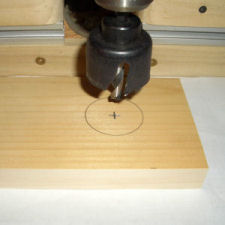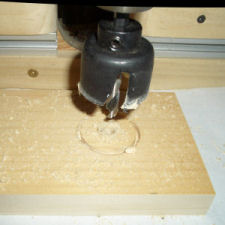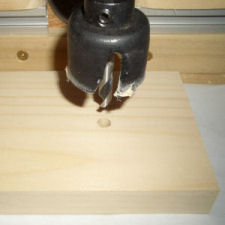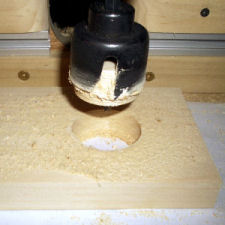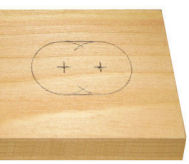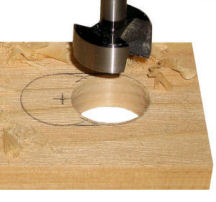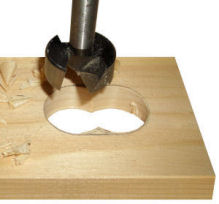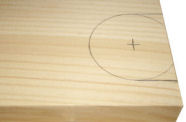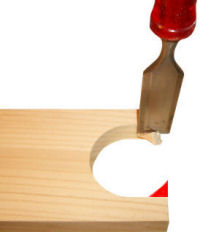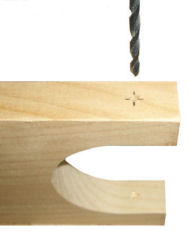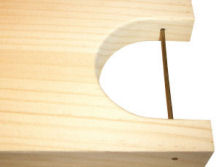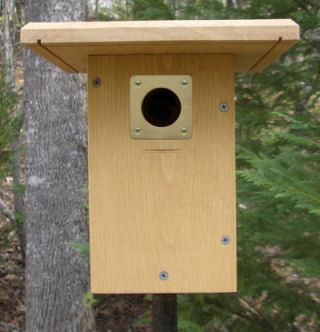
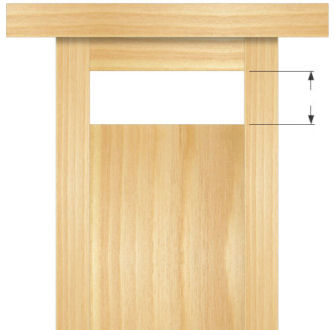
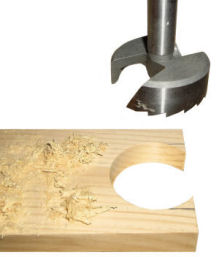
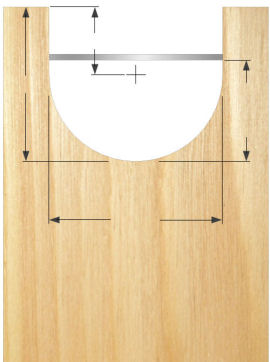
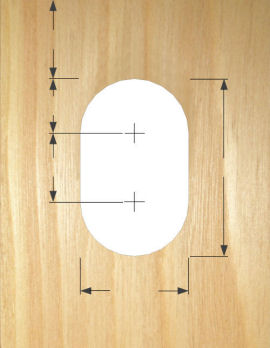
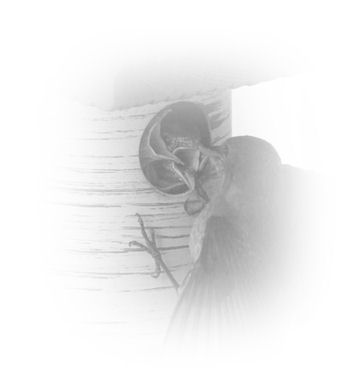
Entrance Holes
Peterson Oval
Designed by Dick Peterson
European Starlings can squeeze through the Peterson oval. When combined with a small cavity nestbox, however, Starlings are usually not a problem.
Designed by Dick Peterson
European Starlings can squeeze through the Peterson oval. When combined with a small cavity nestbox, however, Starlings are usually not a problem.
2 1/4"
1 3/8"
Round Entry
Note: a round entry 1 9/16" or smaller will exclude European Starlings. A 1 1/8" or smaller round entry will exclude House Sparrows.
Note: a round entry 1 9/16" or smaller will exclude European Starlings. A 1 1/8" or smaller round entry will exclude House Sparrows.
1. Mark entry hole location. Place a piece of scrap wood under the panel. Align pilot bit with mark (hole saw shown).
2. Drill half way through panel. Make sure only the small pilot bit cuts through back side. Retract bit.
3. Turn panel over. Align pilot bit with the hole made by the pilot bit in the first pass.
4. Drill remainder of hole and retract bit. The plug will remain inside the cutting drum. Lightly sand the sharp edges from the entry (both sides).
|
Species
|
Diameter
|
|
Ash-throated Flycatcher
|
1 9/16" - 1 3/4"
|
|
Brown-headed Nuthatch
|
1 1/2" - 1 9/16"
|
|
Carolina Wren
|
1 1/2" - 1 9/16"
|
|
Chickadee
|
1 1/8" - 1 1/4"
|
|
Eastern Bluebird
|
1 1/2" - 1 9/16"
|
|
Mountain Bluebird
|
1 9/16"
|
|
Prothonotary Warbler
|
1 1/8" - 1 1/4"
|
|
Titmouse
|
1 1/4"
|
|
Tree Swallow
|
1 1/2" - 1 9/16"
|
|
Western Bluebird
|
1 9/16"
|
|
White-breasted Nuthatch
|
1 1/4"
|
2"
7/8"
2 1/4"
1 1/4" -
1 3/8"
1 3/8"


1. Mark center lines on panel (we've drawn the entire entry to show what we'll be cutting).
2. Align bit with your center mark and drill hole (Forstner bit shown).
3. Using a chisel, remove the material as shown (red area). Sand edges smooth.
4. Measure 5/8" down from top of door. Drill 1/8" hole through both sides of door for wire.
5. Cut 1/8" wire width of door. Apply a small amount of glue and insert into door as shown.
1. Mark centerlines. We've drawn the entire entry to show what we'll be cutting.
2. Align bit with top mark and drill first hole (Forstner bit shown).
3. Align bit with bottom mark and drill second hole.
4. Using a chisel, remove material between holes. Sand the chisel cut and the edges, being careful not to enlarge the entry itself.
Gilwood Entry
Designed by Steve Gilbertson
A wire spanning the width of this entry reduces functional height but does not restrict air flow. The wire should be adjusted for a 1 1/4" to 1 3/8" space. Starlings can squeeze through this entry.
Designed by Steve Gilbertson
A wire spanning the width of this entry reduces functional height but does not restrict air flow. The wire should be adjusted for a 1 1/4" to 1 3/8" space. Starlings can squeeze through this entry.

1 3/16"
Entries should be sized for the species you plan on attracting to your nestbox and no larger. In some cases an entry just 1/16" oversized will allow a competitor species, such as the European Starling, to gain access to the box.
Fortunately, hole saws and bits are available that provide the precision needed to make accurately sized holes.
The following sections show five predominant entries in use today, with illustrations and instructions on how to drill or make them.
Fortunately, hole saws and bits are available that provide the precision needed to make accurately sized holes.
The following sections show five predominant entries in use today, with illustrations and instructions on how to drill or make them.
Building a nestbox tutorials
Nestbox materials
Tools
Fasteners
Entrance holes
Adhesives and caulk
Finishing
Nestbox materials
Tools
Fasteners
Entrance holes
Adhesives and caulk
Finishing
Home | Site Map | Disclaimer | Contact Us
Copyright © 2012 NestboxBuilder.com
This site was last updated on 01/01/2016
Copyright © 2012 NestboxBuilder.com
This site was last updated on 01/01/2016
The Slot Entry
Nestboxes with a horizontal slot rather than a conventional round or oval entry were designed to be less attractive to House Sparrows. These boxes are usually very shallow and have a small nest cavity. In some areas House Sparrows do not favor this combination, while in other regions slot boxes have no effect in deterring them. It is generally agreed that the small, shallow cavity of a slot box has more to do with deterring House Sparrows than the slot itself.
House Wrens may prefer slot entries as it's easier for them to bring in the sticks they use for nesting material.
The slot entry may provide an escape route for adults in the event of a predator attack.
Nestboxes with a horizontal slot rather than a conventional round or oval entry were designed to be less attractive to House Sparrows. These boxes are usually very shallow and have a small nest cavity. In some areas House Sparrows do not favor this combination, while in other regions slot boxes have no effect in deterring them. It is generally agreed that the small, shallow cavity of a slot box has more to do with deterring House Sparrows than the slot itself.
House Wrens may prefer slot entries as it's easier for them to bring in the sticks they use for nesting material.
The slot entry may provide an escape route for adults in the event of a predator attack.
1"
7/8"
11/16"
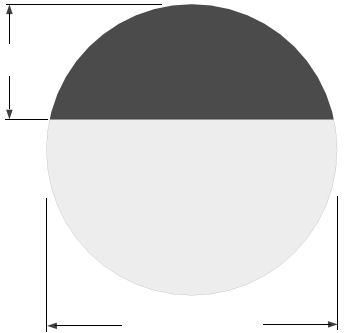
3" diameter circle
1 3/16"
Starling Resistant Entrance Hole
The "SREH" was developed by Mr. Charles McEwen to exclude the European Starling from Purple Martin houses. The dimensions are critical as even slightly too large the entry will admit Starlings; too small and the entry will exclude Purple Martins.
The entry should be cut slightly undersized with a jig saw then sanded or filed to precisely the finished size.
For more information on this entry, and on Purple Martins in general, visit the Purple Martin Conservation Assocation
The "SREH" was developed by Mr. Charles McEwen to exclude the European Starling from Purple Martin houses. The dimensions are critical as even slightly too large the entry will admit Starlings; too small and the entry will exclude Purple Martins.
The entry should be cut slightly undersized with a jig saw then sanded or filed to precisely the finished size.
For more information on this entry, and on Purple Martins in general, visit the Purple Martin Conservation Assocation


Hole restrictors
It's common to discover a species using your nestbox that can use a smaller entry than the existing one. To keep larger birds from evicting them, a hole restrictor sized for the smaller bird can be added over the larger one.
Nestlings that fledge prematurely normally will not remain in the box if you put them back. A 1" hole restrictor can be installed to prevent them from leaving again. It must be removed before anticipated fledging, or if you see the parents are unable to continue feeding them.
Hole restrictors are available in metal or you can make one yourself with a wood block, plastic from a milk jug or even cardboard in an emergency.
Metal hole restrictors are also used to prevent woodpeckers and squirrels from "remodeling" the entry, or to make repairs if they already have. They may be installed on either the exterior or interior.
It's common to discover a species using your nestbox that can use a smaller entry than the existing one. To keep larger birds from evicting them, a hole restrictor sized for the smaller bird can be added over the larger one.
Nestlings that fledge prematurely normally will not remain in the box if you put them back. A 1" hole restrictor can be installed to prevent them from leaving again. It must be removed before anticipated fledging, or if you see the parents are unable to continue feeding them.
Hole restrictors are available in metal or you can make one yourself with a wood block, plastic from a milk jug or even cardboard in an emergency.
Metal hole restrictors are also used to prevent woodpeckers and squirrels from "remodeling" the entry, or to make repairs if they already have. They may be installed on either the exterior or interior.
